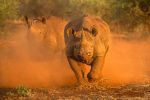– Supa oleng, Samburu Masaien Jimpian greets us with a smile. We jump into the open Landrover. Jimpian tells us that we have about a two hour drive to Rhino Camp, gives us each a chilled water bottle and asks if we are ready for the bush. It is us!
We are heading north into this giant conservation area and towards the Sera Conservancy – famous for its rhino sanctuary run by the Samburu Masaier. We arrive at a dried-up riverbed surrounded by doum palms. Here we meet the manager at Rhino Camp, our new home for a number of days. Our accommodation is tastefully designed to protect us from the hot sun. Right in front of our tent we see elephants approaching the water hole to quench their thirst.. They move almost silently, but the rumbling sound from the elephant’s stomach reveals that they are here.
Here we will track one of the 20 black rhinos found in the 107 km2 reserve. Along the way we see animals and bird species typical of northern Kenya such as; gerenuk antelopes, reticulated giraffes, wild cats, various species of mongoose, vultures, eagles.
Tina & Ulrika/Ecolyx
If you want to experience Rhino Camp, send us a request.
Contact form
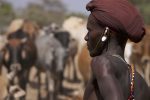
Ecorating: 4.0
This product meets our requirements for Ecorating, a product that is good for humans and the environment.
Does my trip make a difference?
Read more
This product meets our requirements for Ecorating, a product that is good for humans and the environment.
Sample Itinerary

Welcome to the wild & beautiful – Sera Conservancy, Northern Kenya. Saruni Rhino is a small tented camp with only three bandas / tents located on a dry river bed surrounded by doum palms in the middle of the wild landscape – a perfect oasis in the middle of the barren. This is truly an undiscovered hidden gem. The tents are spacious and rustically luxurious. The staff consists mostly of Samburu Masai and you will be well taken care of – this is not a run-of-the-mill safari experience 🙂
Here is the first rhino sanctuary owned by local people. Here, they have succeeded in reintroducing the first black rhinos to Northern Kenya. A very cool and unique experience is to track black rhino on foot together with a Saruni guide and a ranger. Black rhinos have poor eyesight. This is actually true of all rhinos. But that doesn’t mean you can sneak up on them. Their sense of smell and hearing is exceptionally good – so on foot, great expertise is required to carry out a trek safely. You hike with an expert guide and a ranger with a weapon, and your escort vehicle is not far away.
The excitement is palpable when you encounter the rhino so close for the first time; palpitations, pulse, curiosity and heightened excitement – it doesn’t get more exciting than this! You will feel tense, maybe a little nervous but it will let go and the magic will happen. We cannot describe it other than a dizzying experience.
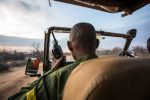
Did you know that the black rhinoceros is critically endangered? The biggest threat to the black rhinoceros is poaching for the international trade in rhino horn. With many efforts to protect rhinos and inform the public, poaching has slowly declined in recent years, and rhino numbers have begun to rise. In the Sera nature reserve, these 20 rhinos are protected in a large fenced area of over 10,000 hectares of land and with rangers patrolling on foot and by car. Here you contribute directly to the protection of these rhinos through your park tickets to the Sera Conservancy.

During the day you do early morning safaris and afternoon safaris, maybe you will see several of the native species of Samburu such as oryx, gerenuk antelope, Grevy’s zebra, reticulated giraffe and black rhino 🙂 back to the camp in time for lunch, enjoy a siesta before going out on afternoon safari that ends with a sundowner in the middle of the wilderness or at the camp.
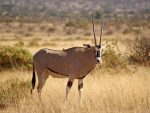
The beautiful oryx antelope is native to Samburu.

Herds of elephants also populate this vast landscape and also offer great bird watching and cultural experiences with the Singing wells – where local people come to water their animals.
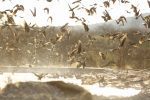
Also experience the spectacle when tens of thousands of Sandgrouse birds come to drink and wet their feathers in the Singing wells…

Your accommodation consists of deliciously designed bandas – elegantly rustic!

Take a dip in the lovely pool in the middle of the day when it’s hot. The water is surprisingly cooling.
Trip details
Ecorating: 4.0
Season: June – April
Airport: Nairobi Jomo Kenyatta International Airport (NBO)
The price of the trip includes: Flight Nairobi – Samburu return, accommodation, all safaris in an open jeep with a Samburu guide, full board with drinks (house wines, beer, soft drinks, water),
The price of the trip does not include: Travel insurance, interantional flights, tip
Combine with: Coastal, eco-luxury safari tour through Kenya’s Rift Valley and/or accommodation in Nairobi.
Good to know about Saruni Rhino: Located within the Sera Conservancy, an 839,000 hectare reserve in wild, northern Kenya.
Travel ethics: In Samburu water is in short supply so use it sparingly. The Maasai are a proud people, always ask before taking photos. Bring small notes in local currency to be able to buy local handicrafts out in the villages. Shake hands with those you meet – a courtesy code here.
Mobile network: Internet access is available at the hotel but sometimes work a little.
E-application:
Applications for visitors to Kenya can be made through www.ecitizen.go.ke by following the instructions below (Applicants should have passport, a passport photo and debit card ready)
Time Zone: GMT + 3
Packing: Someone once said that “Africa is a cold continent blessed by a warm sun….” Days can be extremely hot while nights can be cool. Average annual temperatures vary between 18°C – 30°C, while average annual rainfall is 345 mm with peaks in the months of November and April. You’ll want to bring a pair
sweaters for the morning and evening both long and short trousers, good and sturdy walking shoes. Colors should allow you to blend into the environment as much as possible, so choose different shades of green, brown, yellow or red that characterize the African soil and vegetation. Bring hat and sunglasses. Soft bags are easier to pack in the cars you travel with, if you fly, the maximum weight is 15 kg per person. Mosquito nets are available, but please bring mosquito spray.
Local Currency: Kenyan Shilling
Please note: Kenya has introduced a ban on seat bags and this is checked at customs. The introduction of seat bags can result in hefty fines.
Water: Clean water is available at the camp.
Safety: Your safety is our priority. In Nairobi you should not wander around alone and avoid certain places Down Town and avoid crowds.
Travel entry requirements: : All travelers to Kenya must apply for and be approved for an Electronic Travel Authorization (eTA) to visit the country. Click on the link below and follow their instructions (Applicants should have their passport and travel information and payment card ready). The price is 35 USD per person including children. If you are a family traveling, you can apply together. Apply no later than 3 weeks before departure. Se mer här: Electronic Travel Authorisation (eTA)

Ecorating: 4.0
This product meets our requirements for Ecorating, a product that is good for humans and the environment.
Does my trip make a difference?
Read more
This product meets our requirements for Ecorating, a product that is good for humans and the environment.
Saruni Rhino / Sera Conservancy
You, as a guest, actively contribute to the protection of the iconic rhinoceros when you visit the Sera Conservancy. Furthermore, the local population is supported in the form of employment and social initiatives of various kinds.
Since its inception in 2003, Saruni has identified and nurtured a close connection with the indigenous peoples who own the areas where fauna and flora thrive. Saruni’s choice to invest in Kenya was actually influenced by the tradition of community-based tourism in the country and by the cultural element that differentiates a safari experience in Kenya from other safari tours in the rest of Africa.
Community
Saruni employs local people (85% of the staff are members of the local Samburu community). Saruni also supports the community with income from park tickets (used not only to run conservation but also to provide members with support in areas such as health and education). The camp strongly highlights the Samburu community’s culture, tradition and heritage. The camp is the main commercial source of income for the community in the Sera Conservancy where the Saruni Rhino is located.
Conservation project
The first community-owned rhino sanctuary in Africa
The Sera Community Conservancy is home to approximately 16,000 Samburu semi-nomadic pastoralists who form part of the Maasai sub-tribe. This is where a very secure and fenced sanctuary was created for black rhinos reintroduced to the Sera Conservancy. The Rhino Reserve’s aim is to spread and increase Kenya’s black rhino population and encourage visitors to this remote and stunning part of Kenya via a fully community-focused ideology that encourages the sustainable benefits of conservation that Saruni so strongly believes in.
It is also proud to be part of the Northern Rangelands Trust (NRT) – a leading conservation organization in Kenya, demonstrating the important link between communities, conservation and wildlife, a relationship fueled by tourism.
To know more about ‘Community-Led Wildlife Conservation in Kenya’, read this interview with Saruni’s founder and CEO, Riccardo Orizio, HERE.
